Corporate and Financial Accounting Task 2022
VerifiedAdded on 2022/09/17
|11
|3503
|15
AI Summary
Contribute Materials
Your contribution can guide someone’s learning journey. Share your
documents today.
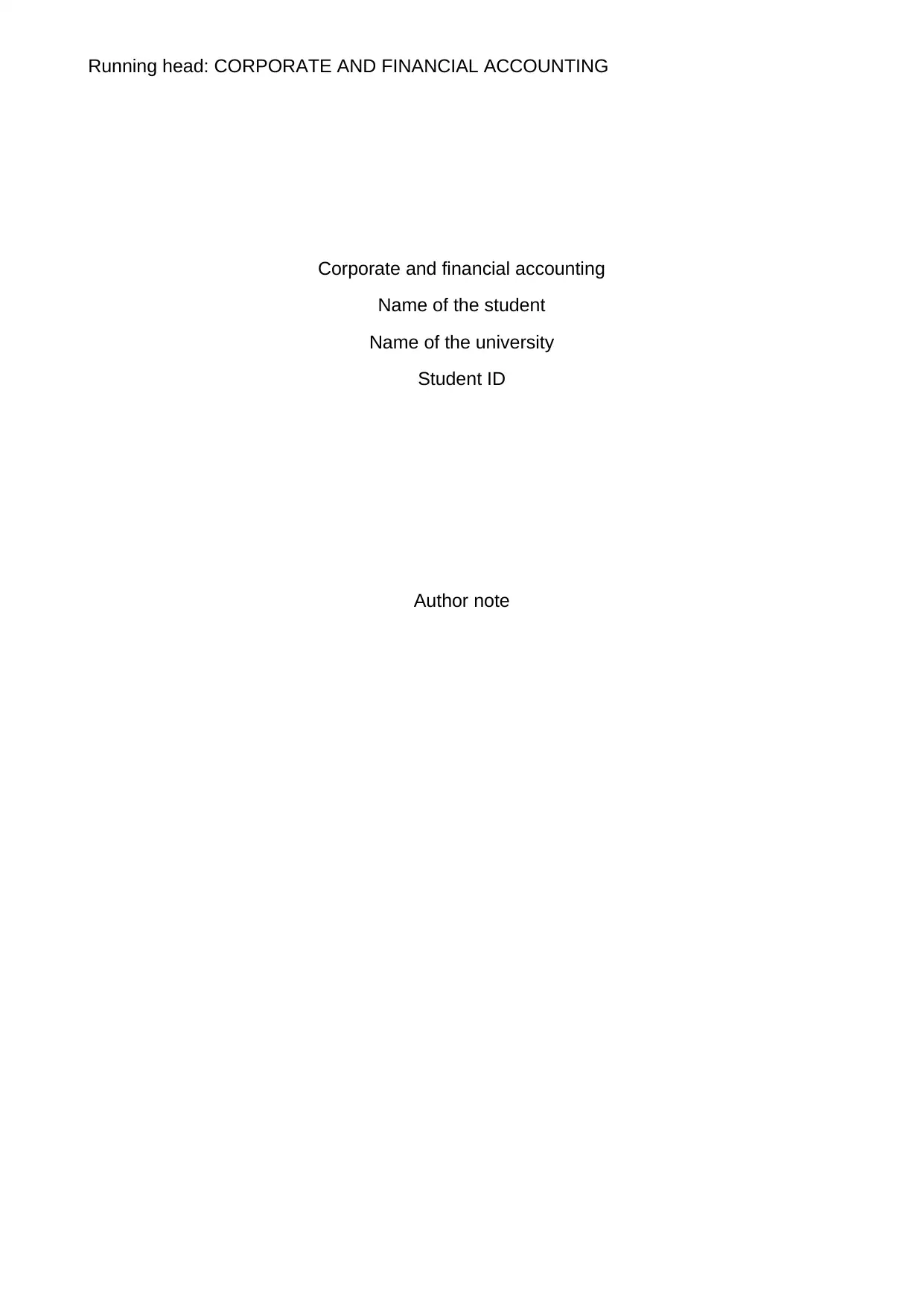
Running head: CORPORATE AND FINANCIAL ACCOUNTING
Corporate and financial accounting
Name of the student
Name of the university
Student ID
Author note
Corporate and financial accounting
Name of the student
Name of the university
Student ID
Author note
Secure Best Marks with AI Grader
Need help grading? Try our AI Grader for instant feedback on your assignments.
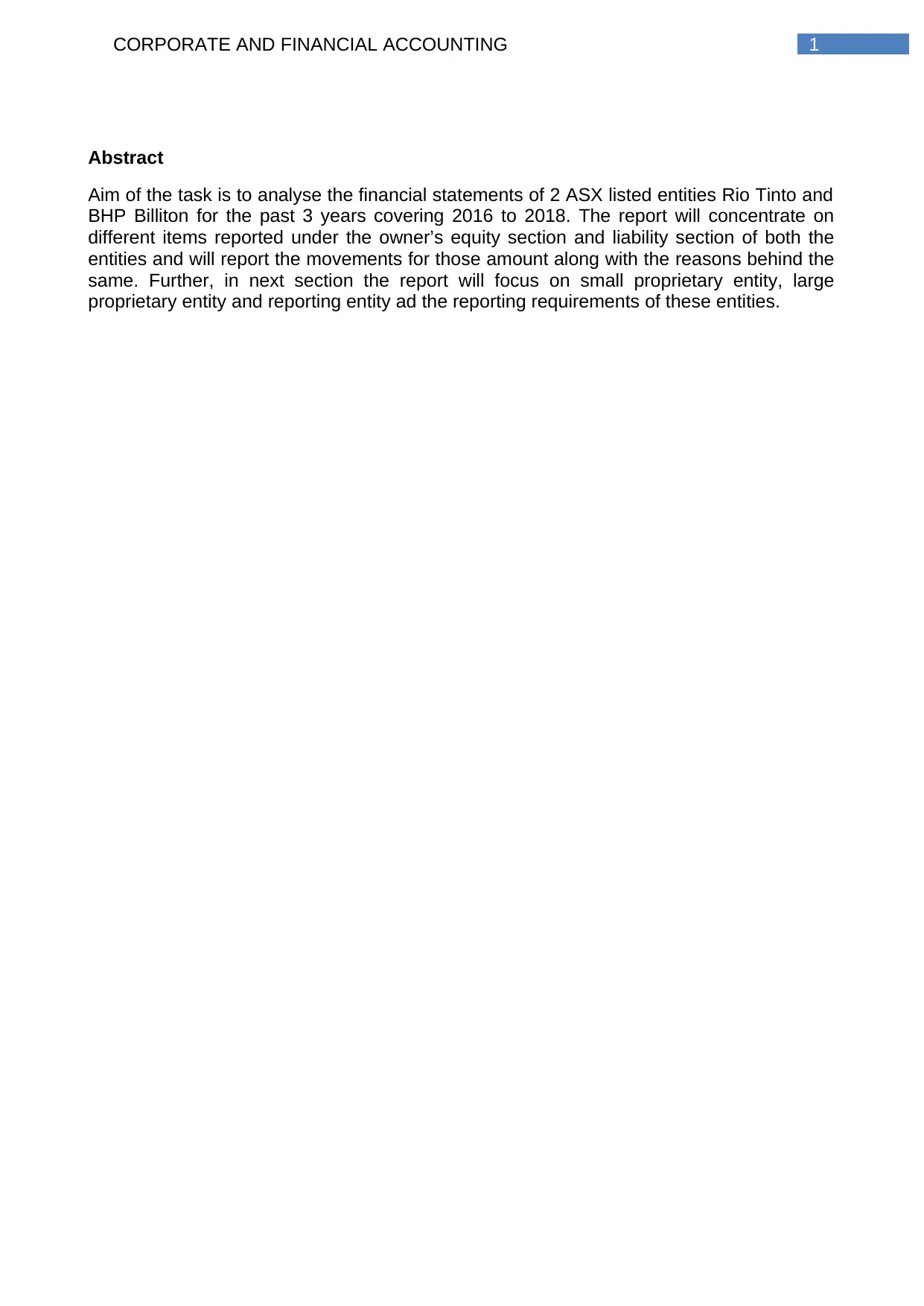
1CORPORATE AND FINANCIAL ACCOUNTING
Abstract
Aim of the task is to analyse the financial statements of 2 ASX listed entities Rio Tinto and
BHP Billiton for the past 3 years covering 2016 to 2018. The report will concentrate on
different items reported under the owner’s equity section and liability section of both the
entities and will report the movements for those amount along with the reasons behind the
same. Further, in next section the report will focus on small proprietary entity, large
proprietary entity and reporting entity ad the reporting requirements of these entities.
Abstract
Aim of the task is to analyse the financial statements of 2 ASX listed entities Rio Tinto and
BHP Billiton for the past 3 years covering 2016 to 2018. The report will concentrate on
different items reported under the owner’s equity section and liability section of both the
entities and will report the movements for those amount along with the reasons behind the
same. Further, in next section the report will focus on small proprietary entity, large
proprietary entity and reporting entity ad the reporting requirements of these entities.

2CORPORATE AND FINANCIAL ACCOUNTING
Table of Contents
Introduction............................................................................................................................3
Part A.....................................................................................................................................3
(i) Owner’s equity............................................................................................................3
(ii) Movement of each item under owner’s equity..........................................................4
(iii) Liability......................................................................................................................5
(iv) Movement of each item under owner’s equity..........................................................6
(v) Advantages and disadvantages of source of funds.................................................7
Part B.....................................................................................................................................8
Conclusion.............................................................................................................................9
Reference.............................................................................................................................10
Table of Contents
Introduction............................................................................................................................3
Part A.....................................................................................................................................3
(i) Owner’s equity............................................................................................................3
(ii) Movement of each item under owner’s equity..........................................................4
(iii) Liability......................................................................................................................5
(iv) Movement of each item under owner’s equity..........................................................6
(v) Advantages and disadvantages of source of funds.................................................7
Part B.....................................................................................................................................8
Conclusion.............................................................................................................................9
Reference.............................................................................................................................10

3CORPORATE AND FINANCIAL ACCOUNTING
Introduction
Being the pioneer in metal and mining sector, Rio Tinto is engaged in producing
essential material required for human progress. Major products of the organisation include
copper, aluminium, gold, diamond, uranium, iron ore and industrial materials including
titanium oxides, borates and salt. Minerals and metals produced by them plays major role
in hosting day to day items as well as innovative technologies. That assists in working in
modern life (Riotinto.com 2019). On the other hand, BHP Billiton that is the outcome of a
merger among Billiton and Broken Hill Proprietary (BHP). It is engaged in production of
copper, steel, silver, oil, gas and aluminium. It has interests in transportation and
engineering (BHP 2019.).
Part A
Balance sheet of the entity represents the shareholder’s equity, assets and liabilities
at a particular point of time and offers the basis to compute the return rate and analysis of
capital structure.
(i) Owner’s equity
Rio Tinto – looking into the balance sheet of Rio Tinto for the past 3 years covering the
years 2016 to 2018 it can be identified that the owner’s equity section of the balance sheet
includes the following items –
Share capital – share capital is the fund raised by the entity in exchange of
issuance of ownership interests in entity though shares. Generally there 2 types of
share capital including preferred stock and common stock. However share capital
of Rio Tinto only includes ordinary shares. An ordinary share that is also known as
common shares are with lower priority for the assets of the entity and receive only
dividends with the managements of the entity’s discretion (Williams and Dobelman
2017).
Share premium account – it represents the difference among the issue or
subscription price and share’s par value. This account is statutory reserve account
and is not distributable.
Other reserves – other reserves of Rio Tinto includes different reserves like capital
redemption reserves, cash flow hedge reserve, revaluation reserve on account of
available for sale and foreign currency translation reserve (Robinson et al. 2015).
Retained earnings – it is the profit generated by the firm which is not distributable to
the stockholders and is reported after making payment for dividends. If the entity
has large amount of retained earning balance it suggests that the entity is
financially healthy (Wahlen, Baginski and Bradshaw 2014)
BHP Billiton – looking into the balance sheet of BHP Billiton for the past 3 years covering
the years 2016 to 2018 it can be identified that the owner’s equity section of the balance
sheet includes the following items –
Share capital – share capital of BHP Billiton includes fully paid ordinary shares,
shares with special voting and preference shares. Shares with special voting are
issued by BHP Billiton and BHP Billiton Plc. jointly to facilitate the joint voting by the
shareholders. Preference shares are with the right of repayments for the value paid
up on nominal value and unpaid dividends, if any on prior basis against holder of
other share class in the instance of winding up or return of the capital (Hotchkiss,
Strömberg and Smith 2014)
Introduction
Being the pioneer in metal and mining sector, Rio Tinto is engaged in producing
essential material required for human progress. Major products of the organisation include
copper, aluminium, gold, diamond, uranium, iron ore and industrial materials including
titanium oxides, borates and salt. Minerals and metals produced by them plays major role
in hosting day to day items as well as innovative technologies. That assists in working in
modern life (Riotinto.com 2019). On the other hand, BHP Billiton that is the outcome of a
merger among Billiton and Broken Hill Proprietary (BHP). It is engaged in production of
copper, steel, silver, oil, gas and aluminium. It has interests in transportation and
engineering (BHP 2019.).
Part A
Balance sheet of the entity represents the shareholder’s equity, assets and liabilities
at a particular point of time and offers the basis to compute the return rate and analysis of
capital structure.
(i) Owner’s equity
Rio Tinto – looking into the balance sheet of Rio Tinto for the past 3 years covering the
years 2016 to 2018 it can be identified that the owner’s equity section of the balance sheet
includes the following items –
Share capital – share capital is the fund raised by the entity in exchange of
issuance of ownership interests in entity though shares. Generally there 2 types of
share capital including preferred stock and common stock. However share capital
of Rio Tinto only includes ordinary shares. An ordinary share that is also known as
common shares are with lower priority for the assets of the entity and receive only
dividends with the managements of the entity’s discretion (Williams and Dobelman
2017).
Share premium account – it represents the difference among the issue or
subscription price and share’s par value. This account is statutory reserve account
and is not distributable.
Other reserves – other reserves of Rio Tinto includes different reserves like capital
redemption reserves, cash flow hedge reserve, revaluation reserve on account of
available for sale and foreign currency translation reserve (Robinson et al. 2015).
Retained earnings – it is the profit generated by the firm which is not distributable to
the stockholders and is reported after making payment for dividends. If the entity
has large amount of retained earning balance it suggests that the entity is
financially healthy (Wahlen, Baginski and Bradshaw 2014)
BHP Billiton – looking into the balance sheet of BHP Billiton for the past 3 years covering
the years 2016 to 2018 it can be identified that the owner’s equity section of the balance
sheet includes the following items –
Share capital – share capital of BHP Billiton includes fully paid ordinary shares,
shares with special voting and preference shares. Shares with special voting are
issued by BHP Billiton and BHP Billiton Plc. jointly to facilitate the joint voting by the
shareholders. Preference shares are with the right of repayments for the value paid
up on nominal value and unpaid dividends, if any on prior basis against holder of
other share class in the instance of winding up or return of the capital (Hotchkiss,
Strömberg and Smith 2014)
Secure Best Marks with AI Grader
Need help grading? Try our AI Grader for instant feedback on your assignments.

4CORPORATE AND FINANCIAL ACCOUNTING
Treasury shares – it is the part of shares that is kept by an entity as its own shares.
It generally comes from the part of float and the outstanding shares before it is
repurchased by the entity or that has not been issued to the public ever. While the
entity buys back these shares the same become (Schroeder, Clark and Cathey
2019)
Other reserves – other reserves of the entity includes share premium account,
employee share awards reserves, foreign currency translation reserves, hedging
reserves, financial asset reserves, non-controlling interest contribution reserves and
share buyback reserves
Retained earnings – it is the profits earned by the entity till closing of the year 2018
after deducting the amount of dividend and any amount distributed to the investors.
The same is adjusted if any entry is made that has an impact on the expense or
revenue account (Cao, Chychyla and Stewart 2015)
(ii) Movement of each item under owner’s equity
Rio Tinto – movements and reasons for the same in owner’s equity of the entity are as
follows –
Share capital – analysing the share capital under owner’s equity for the past 3 years
it can be identified that the same has been increased to $ 4360 million in 2017 from
$ 4139 million in 2016, however the same reduced to $ 3688 in 2018. Reason
behind the fluctuation is current translation that generated on share capital of Rio
Tinto Limited’s share capital and buy back of shares.
Share premium account – analysing the share premium account under owner’s
equity for the past 3 years it can be identified that the same has been maintained at
same level that is at $ 4306 million for both 2016 and 2017, however the same
increased to $ 4312 in 2018.
Other reserves – analysing other reserves reported under owner’s equity for the
past 3 years it can be identified that the same has been increased to $ 12,284
million in 2017 from $ 9,216 million in 2016, however the same reduced to $ 8,661
in 2018. Reason behind the fluctuation is gains or losses from cash flow hedges
and tax on the same. Another reason of changes is purchase of own share from Rio
Tinto Limited shareholder for satisfying share option.
Retained earnings – analysing retained earnings reported under owner’s equity for
the past 3 years it can be identified that the same has been in increasing trend and
went up to $ 23,761 million in 2017 from $ 21,631 million in 2016 and further went
up to $ 27,025 in 2018. Reason of increase was receipt of profit from parent and
subsidiaries and actuarial gains.
BHP Billiton – movements and reasons for the same in owner’s equity of the entity are as
follows –
Treasury shares – it is the part of shares that is kept by an entity as its own shares.
It generally comes from the part of float and the outstanding shares before it is
repurchased by the entity or that has not been issued to the public ever. While the
entity buys back these shares the same become (Schroeder, Clark and Cathey
2019)
Other reserves – other reserves of the entity includes share premium account,
employee share awards reserves, foreign currency translation reserves, hedging
reserves, financial asset reserves, non-controlling interest contribution reserves and
share buyback reserves
Retained earnings – it is the profits earned by the entity till closing of the year 2018
after deducting the amount of dividend and any amount distributed to the investors.
The same is adjusted if any entry is made that has an impact on the expense or
revenue account (Cao, Chychyla and Stewart 2015)
(ii) Movement of each item under owner’s equity
Rio Tinto – movements and reasons for the same in owner’s equity of the entity are as
follows –
Share capital – analysing the share capital under owner’s equity for the past 3 years
it can be identified that the same has been increased to $ 4360 million in 2017 from
$ 4139 million in 2016, however the same reduced to $ 3688 in 2018. Reason
behind the fluctuation is current translation that generated on share capital of Rio
Tinto Limited’s share capital and buy back of shares.
Share premium account – analysing the share premium account under owner’s
equity for the past 3 years it can be identified that the same has been maintained at
same level that is at $ 4306 million for both 2016 and 2017, however the same
increased to $ 4312 in 2018.
Other reserves – analysing other reserves reported under owner’s equity for the
past 3 years it can be identified that the same has been increased to $ 12,284
million in 2017 from $ 9,216 million in 2016, however the same reduced to $ 8,661
in 2018. Reason behind the fluctuation is gains or losses from cash flow hedges
and tax on the same. Another reason of changes is purchase of own share from Rio
Tinto Limited shareholder for satisfying share option.
Retained earnings – analysing retained earnings reported under owner’s equity for
the past 3 years it can be identified that the same has been in increasing trend and
went up to $ 23,761 million in 2017 from $ 21,631 million in 2016 and further went
up to $ 27,025 in 2018. Reason of increase was receipt of profit from parent and
subsidiaries and actuarial gains.
BHP Billiton – movements and reasons for the same in owner’s equity of the entity are as
follows –
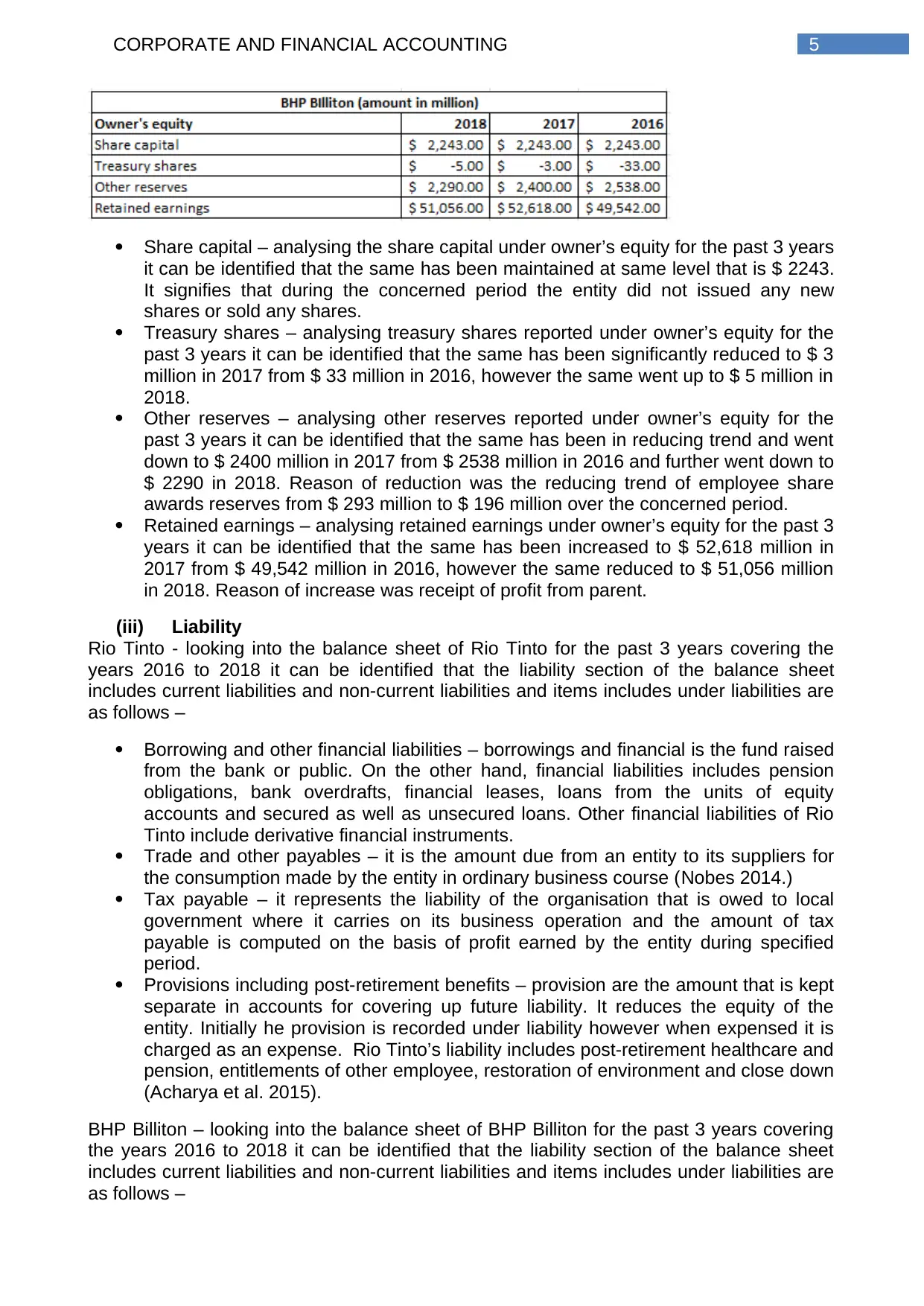
5CORPORATE AND FINANCIAL ACCOUNTING
Share capital – analysing the share capital under owner’s equity for the past 3 years
it can be identified that the same has been maintained at same level that is $ 2243.
It signifies that during the concerned period the entity did not issued any new
shares or sold any shares.
Treasury shares – analysing treasury shares reported under owner’s equity for the
past 3 years it can be identified that the same has been significantly reduced to $ 3
million in 2017 from $ 33 million in 2016, however the same went up to $ 5 million in
2018.
Other reserves – analysing other reserves reported under owner’s equity for the
past 3 years it can be identified that the same has been in reducing trend and went
down to $ 2400 million in 2017 from $ 2538 million in 2016 and further went down to
$ 2290 in 2018. Reason of reduction was the reducing trend of employee share
awards reserves from $ 293 million to $ 196 million over the concerned period.
Retained earnings – analysing retained earnings under owner’s equity for the past 3
years it can be identified that the same has been increased to $ 52,618 million in
2017 from $ 49,542 million in 2016, however the same reduced to $ 51,056 million
in 2018. Reason of increase was receipt of profit from parent.
(iii) Liability
Rio Tinto - looking into the balance sheet of Rio Tinto for the past 3 years covering the
years 2016 to 2018 it can be identified that the liability section of the balance sheet
includes current liabilities and non-current liabilities and items includes under liabilities are
as follows –
Borrowing and other financial liabilities – borrowings and financial is the fund raised
from the bank or public. On the other hand, financial liabilities includes pension
obligations, bank overdrafts, financial leases, loans from the units of equity
accounts and secured as well as unsecured loans. Other financial liabilities of Rio
Tinto include derivative financial instruments.
Trade and other payables – it is the amount due from an entity to its suppliers for
the consumption made by the entity in ordinary business course (Nobes 2014.)
Tax payable – it represents the liability of the organisation that is owed to local
government where it carries on its business operation and the amount of tax
payable is computed on the basis of profit earned by the entity during specified
period.
Provisions including post-retirement benefits – provision are the amount that is kept
separate in accounts for covering up future liability. It reduces the equity of the
entity. Initially he provision is recorded under liability however when expensed it is
charged as an expense. Rio Tinto’s liability includes post-retirement healthcare and
pension, entitlements of other employee, restoration of environment and close down
(Acharya et al. 2015).
BHP Billiton – looking into the balance sheet of BHP Billiton for the past 3 years covering
the years 2016 to 2018 it can be identified that the liability section of the balance sheet
includes current liabilities and non-current liabilities and items includes under liabilities are
as follows –
Share capital – analysing the share capital under owner’s equity for the past 3 years
it can be identified that the same has been maintained at same level that is $ 2243.
It signifies that during the concerned period the entity did not issued any new
shares or sold any shares.
Treasury shares – analysing treasury shares reported under owner’s equity for the
past 3 years it can be identified that the same has been significantly reduced to $ 3
million in 2017 from $ 33 million in 2016, however the same went up to $ 5 million in
2018.
Other reserves – analysing other reserves reported under owner’s equity for the
past 3 years it can be identified that the same has been in reducing trend and went
down to $ 2400 million in 2017 from $ 2538 million in 2016 and further went down to
$ 2290 in 2018. Reason of reduction was the reducing trend of employee share
awards reserves from $ 293 million to $ 196 million over the concerned period.
Retained earnings – analysing retained earnings under owner’s equity for the past 3
years it can be identified that the same has been increased to $ 52,618 million in
2017 from $ 49,542 million in 2016, however the same reduced to $ 51,056 million
in 2018. Reason of increase was receipt of profit from parent.
(iii) Liability
Rio Tinto - looking into the balance sheet of Rio Tinto for the past 3 years covering the
years 2016 to 2018 it can be identified that the liability section of the balance sheet
includes current liabilities and non-current liabilities and items includes under liabilities are
as follows –
Borrowing and other financial liabilities – borrowings and financial is the fund raised
from the bank or public. On the other hand, financial liabilities includes pension
obligations, bank overdrafts, financial leases, loans from the units of equity
accounts and secured as well as unsecured loans. Other financial liabilities of Rio
Tinto include derivative financial instruments.
Trade and other payables – it is the amount due from an entity to its suppliers for
the consumption made by the entity in ordinary business course (Nobes 2014.)
Tax payable – it represents the liability of the organisation that is owed to local
government where it carries on its business operation and the amount of tax
payable is computed on the basis of profit earned by the entity during specified
period.
Provisions including post-retirement benefits – provision are the amount that is kept
separate in accounts for covering up future liability. It reduces the equity of the
entity. Initially he provision is recorded under liability however when expensed it is
charged as an expense. Rio Tinto’s liability includes post-retirement healthcare and
pension, entitlements of other employee, restoration of environment and close down
(Acharya et al. 2015).
BHP Billiton – looking into the balance sheet of BHP Billiton for the past 3 years covering
the years 2016 to 2018 it can be identified that the liability section of the balance sheet
includes current liabilities and non-current liabilities and items includes under liabilities are
as follows –
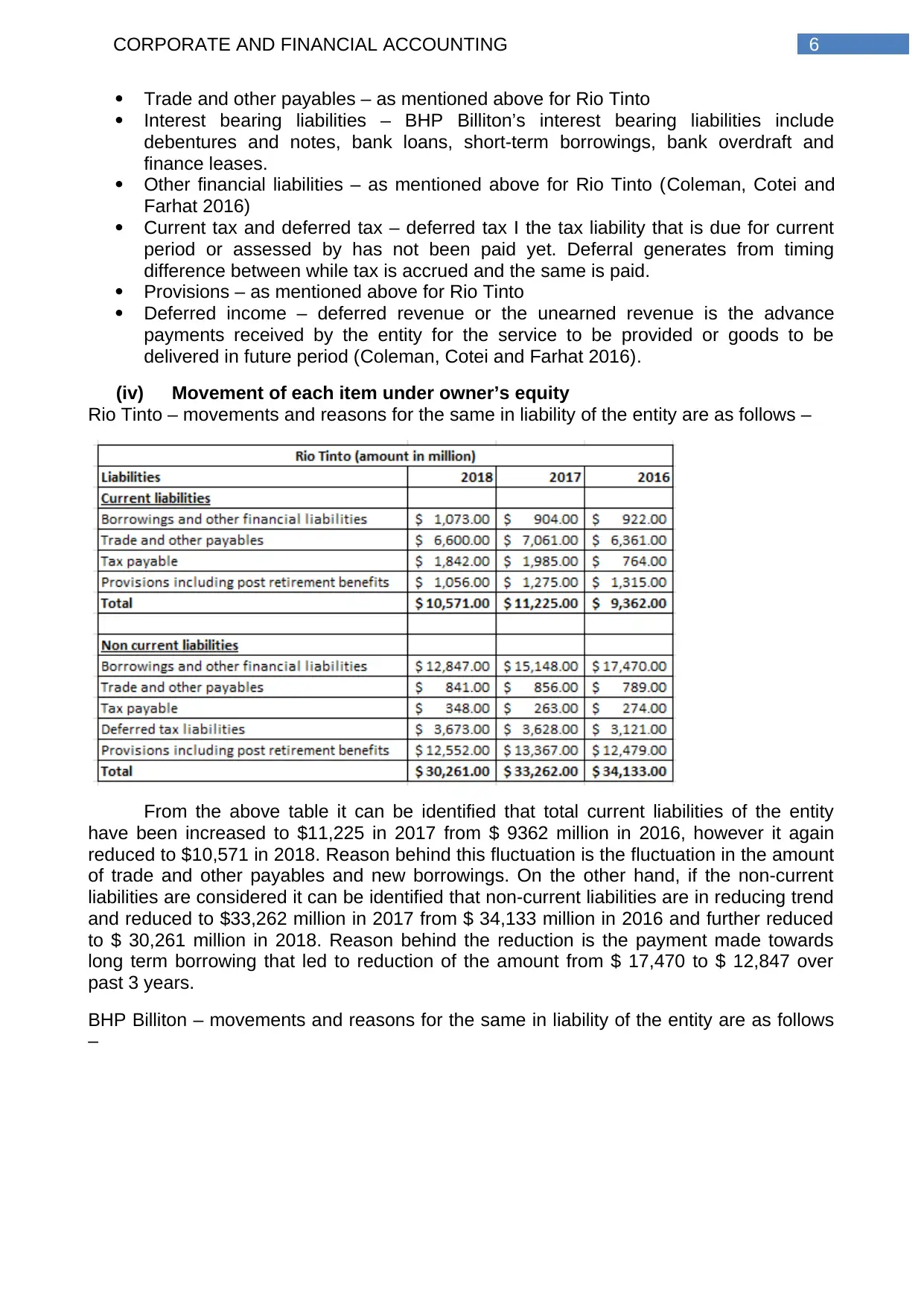
6CORPORATE AND FINANCIAL ACCOUNTING
Trade and other payables – as mentioned above for Rio Tinto
Interest bearing liabilities – BHP Billiton’s interest bearing liabilities include
debentures and notes, bank loans, short-term borrowings, bank overdraft and
finance leases.
Other financial liabilities – as mentioned above for Rio Tinto (Coleman, Cotei and
Farhat 2016)
Current tax and deferred tax – deferred tax I the tax liability that is due for current
period or assessed by has not been paid yet. Deferral generates from timing
difference between while tax is accrued and the same is paid.
Provisions – as mentioned above for Rio Tinto
Deferred income – deferred revenue or the unearned revenue is the advance
payments received by the entity for the service to be provided or goods to be
delivered in future period (Coleman, Cotei and Farhat 2016).
(iv) Movement of each item under owner’s equity
Rio Tinto – movements and reasons for the same in liability of the entity are as follows –
From the above table it can be identified that total current liabilities of the entity
have been increased to $11,225 in 2017 from $ 9362 million in 2016, however it again
reduced to $10,571 in 2018. Reason behind this fluctuation is the fluctuation in the amount
of trade and other payables and new borrowings. On the other hand, if the non-current
liabilities are considered it can be identified that non-current liabilities are in reducing trend
and reduced to $33,262 million in 2017 from $ 34,133 million in 2016 and further reduced
to $ 30,261 million in 2018. Reason behind the reduction is the payment made towards
long term borrowing that led to reduction of the amount from $ 17,470 to $ 12,847 over
past 3 years.
BHP Billiton – movements and reasons for the same in liability of the entity are as follows
–
Trade and other payables – as mentioned above for Rio Tinto
Interest bearing liabilities – BHP Billiton’s interest bearing liabilities include
debentures and notes, bank loans, short-term borrowings, bank overdraft and
finance leases.
Other financial liabilities – as mentioned above for Rio Tinto (Coleman, Cotei and
Farhat 2016)
Current tax and deferred tax – deferred tax I the tax liability that is due for current
period or assessed by has not been paid yet. Deferral generates from timing
difference between while tax is accrued and the same is paid.
Provisions – as mentioned above for Rio Tinto
Deferred income – deferred revenue or the unearned revenue is the advance
payments received by the entity for the service to be provided or goods to be
delivered in future period (Coleman, Cotei and Farhat 2016).
(iv) Movement of each item under owner’s equity
Rio Tinto – movements and reasons for the same in liability of the entity are as follows –
From the above table it can be identified that total current liabilities of the entity
have been increased to $11,225 in 2017 from $ 9362 million in 2016, however it again
reduced to $10,571 in 2018. Reason behind this fluctuation is the fluctuation in the amount
of trade and other payables and new borrowings. On the other hand, if the non-current
liabilities are considered it can be identified that non-current liabilities are in reducing trend
and reduced to $33,262 million in 2017 from $ 34,133 million in 2016 and further reduced
to $ 30,261 million in 2018. Reason behind the reduction is the payment made towards
long term borrowing that led to reduction of the amount from $ 17,470 to $ 12,847 over
past 3 years.
BHP Billiton – movements and reasons for the same in liability of the entity are as follows
–
Paraphrase This Document
Need a fresh take? Get an instant paraphrase of this document with our AI Paraphraser
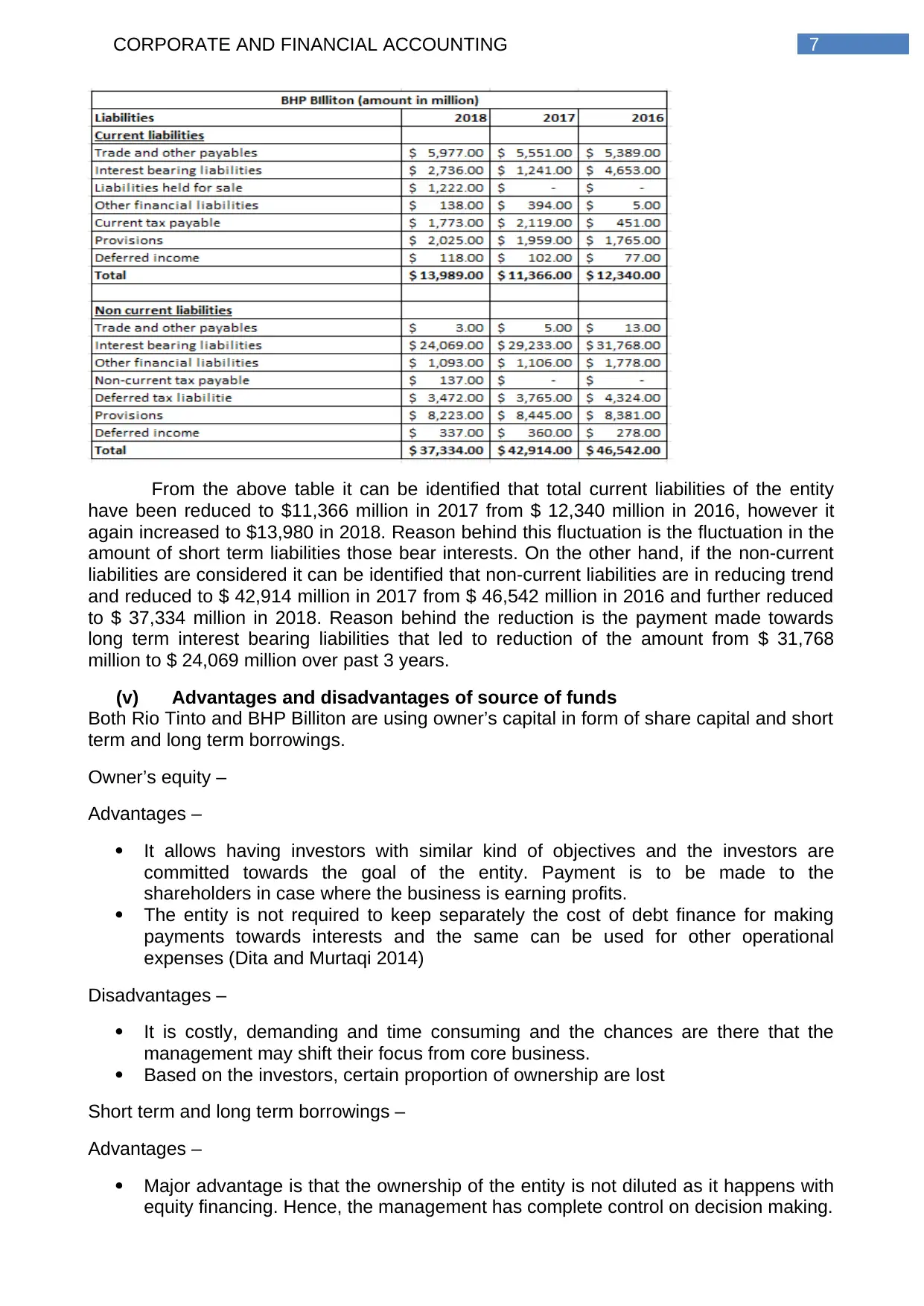
7CORPORATE AND FINANCIAL ACCOUNTING
From the above table it can be identified that total current liabilities of the entity
have been reduced to $11,366 million in 2017 from $ 12,340 million in 2016, however it
again increased to $13,980 in 2018. Reason behind this fluctuation is the fluctuation in the
amount of short term liabilities those bear interests. On the other hand, if the non-current
liabilities are considered it can be identified that non-current liabilities are in reducing trend
and reduced to $ 42,914 million in 2017 from $ 46,542 million in 2016 and further reduced
to $ 37,334 million in 2018. Reason behind the reduction is the payment made towards
long term interest bearing liabilities that led to reduction of the amount from $ 31,768
million to $ 24,069 million over past 3 years.
(v) Advantages and disadvantages of source of funds
Both Rio Tinto and BHP Billiton are using owner’s capital in form of share capital and short
term and long term borrowings.
Owner’s equity –
Advantages –
It allows having investors with similar kind of objectives and the investors are
committed towards the goal of the entity. Payment is to be made to the
shareholders in case where the business is earning profits.
The entity is not required to keep separately the cost of debt finance for making
payments towards interests and the same can be used for other operational
expenses (Dita and Murtaqi 2014)
Disadvantages –
It is costly, demanding and time consuming and the chances are there that the
management may shift their focus from core business.
Based on the investors, certain proportion of ownership are lost
Short term and long term borrowings –
Advantages –
Major advantage is that the ownership of the entity is not diluted as it happens with
equity financing. Hence, the management has complete control on decision making.
From the above table it can be identified that total current liabilities of the entity
have been reduced to $11,366 million in 2017 from $ 12,340 million in 2016, however it
again increased to $13,980 in 2018. Reason behind this fluctuation is the fluctuation in the
amount of short term liabilities those bear interests. On the other hand, if the non-current
liabilities are considered it can be identified that non-current liabilities are in reducing trend
and reduced to $ 42,914 million in 2017 from $ 46,542 million in 2016 and further reduced
to $ 37,334 million in 2018. Reason behind the reduction is the payment made towards
long term interest bearing liabilities that led to reduction of the amount from $ 31,768
million to $ 24,069 million over past 3 years.
(v) Advantages and disadvantages of source of funds
Both Rio Tinto and BHP Billiton are using owner’s capital in form of share capital and short
term and long term borrowings.
Owner’s equity –
Advantages –
It allows having investors with similar kind of objectives and the investors are
committed towards the goal of the entity. Payment is to be made to the
shareholders in case where the business is earning profits.
The entity is not required to keep separately the cost of debt finance for making
payments towards interests and the same can be used for other operational
expenses (Dita and Murtaqi 2014)
Disadvantages –
It is costly, demanding and time consuming and the chances are there that the
management may shift their focus from core business.
Based on the investors, certain proportion of ownership are lost
Short term and long term borrowings –
Advantages –
Major advantage is that the ownership of the entity is not diluted as it happens with
equity financing. Hence, the management has complete control on decision making.
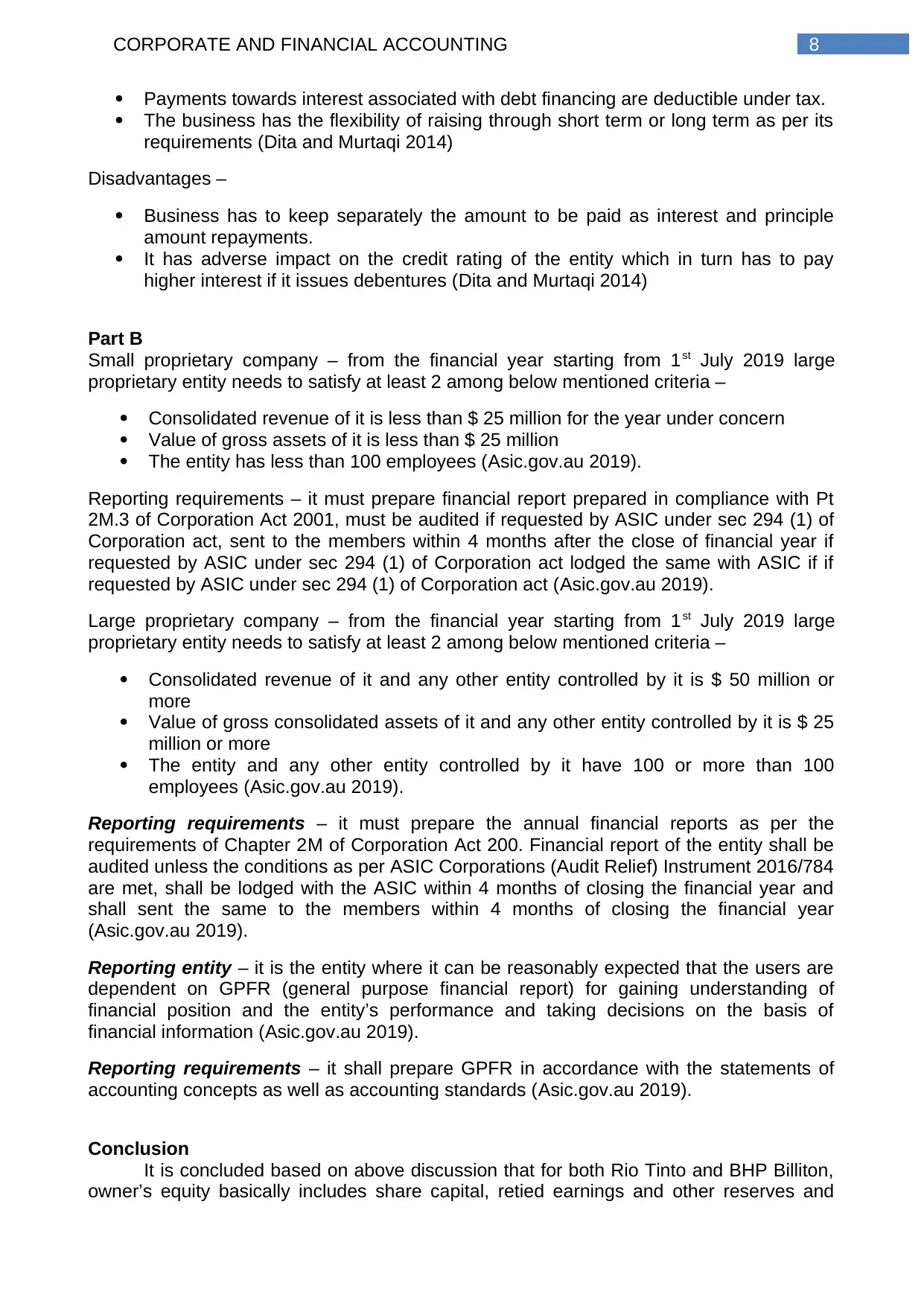
8CORPORATE AND FINANCIAL ACCOUNTING
Payments towards interest associated with debt financing are deductible under tax.
The business has the flexibility of raising through short term or long term as per its
requirements (Dita and Murtaqi 2014)
Disadvantages –
Business has to keep separately the amount to be paid as interest and principle
amount repayments.
It has adverse impact on the credit rating of the entity which in turn has to pay
higher interest if it issues debentures (Dita and Murtaqi 2014)
Part B
Small proprietary company – from the financial year starting from 1st July 2019 large
proprietary entity needs to satisfy at least 2 among below mentioned criteria –
Consolidated revenue of it is less than $ 25 million for the year under concern
Value of gross assets of it is less than $ 25 million
The entity has less than 100 employees (Asic.gov.au 2019).
Reporting requirements – it must prepare financial report prepared in compliance with Pt
2M.3 of Corporation Act 2001, must be audited if requested by ASIC under sec 294 (1) of
Corporation act, sent to the members within 4 months after the close of financial year if
requested by ASIC under sec 294 (1) of Corporation act lodged the same with ASIC if if
requested by ASIC under sec 294 (1) of Corporation act (Asic.gov.au 2019).
Large proprietary company – from the financial year starting from 1st July 2019 large
proprietary entity needs to satisfy at least 2 among below mentioned criteria –
Consolidated revenue of it and any other entity controlled by it is $ 50 million or
more
Value of gross consolidated assets of it and any other entity controlled by it is $ 25
million or more
The entity and any other entity controlled by it have 100 or more than 100
employees (Asic.gov.au 2019).
Reporting requirements – it must prepare the annual financial reports as per the
requirements of Chapter 2M of Corporation Act 200. Financial report of the entity shall be
audited unless the conditions as per ASIC Corporations (Audit Relief) Instrument 2016/784
are met, shall be lodged with the ASIC within 4 months of closing the financial year and
shall sent the same to the members within 4 months of closing the financial year
(Asic.gov.au 2019).
Reporting entity – it is the entity where it can be reasonably expected that the users are
dependent on GPFR (general purpose financial report) for gaining understanding of
financial position and the entity’s performance and taking decisions on the basis of
financial information (Asic.gov.au 2019).
Reporting requirements – it shall prepare GPFR in accordance with the statements of
accounting concepts as well as accounting standards (Asic.gov.au 2019).
Conclusion
It is concluded based on above discussion that for both Rio Tinto and BHP Billiton,
owner’s equity basically includes share capital, retied earnings and other reserves and
Payments towards interest associated with debt financing are deductible under tax.
The business has the flexibility of raising through short term or long term as per its
requirements (Dita and Murtaqi 2014)
Disadvantages –
Business has to keep separately the amount to be paid as interest and principle
amount repayments.
It has adverse impact on the credit rating of the entity which in turn has to pay
higher interest if it issues debentures (Dita and Murtaqi 2014)
Part B
Small proprietary company – from the financial year starting from 1st July 2019 large
proprietary entity needs to satisfy at least 2 among below mentioned criteria –
Consolidated revenue of it is less than $ 25 million for the year under concern
Value of gross assets of it is less than $ 25 million
The entity has less than 100 employees (Asic.gov.au 2019).
Reporting requirements – it must prepare financial report prepared in compliance with Pt
2M.3 of Corporation Act 2001, must be audited if requested by ASIC under sec 294 (1) of
Corporation act, sent to the members within 4 months after the close of financial year if
requested by ASIC under sec 294 (1) of Corporation act lodged the same with ASIC if if
requested by ASIC under sec 294 (1) of Corporation act (Asic.gov.au 2019).
Large proprietary company – from the financial year starting from 1st July 2019 large
proprietary entity needs to satisfy at least 2 among below mentioned criteria –
Consolidated revenue of it and any other entity controlled by it is $ 50 million or
more
Value of gross consolidated assets of it and any other entity controlled by it is $ 25
million or more
The entity and any other entity controlled by it have 100 or more than 100
employees (Asic.gov.au 2019).
Reporting requirements – it must prepare the annual financial reports as per the
requirements of Chapter 2M of Corporation Act 200. Financial report of the entity shall be
audited unless the conditions as per ASIC Corporations (Audit Relief) Instrument 2016/784
are met, shall be lodged with the ASIC within 4 months of closing the financial year and
shall sent the same to the members within 4 months of closing the financial year
(Asic.gov.au 2019).
Reporting entity – it is the entity where it can be reasonably expected that the users are
dependent on GPFR (general purpose financial report) for gaining understanding of
financial position and the entity’s performance and taking decisions on the basis of
financial information (Asic.gov.au 2019).
Reporting requirements – it shall prepare GPFR in accordance with the statements of
accounting concepts as well as accounting standards (Asic.gov.au 2019).
Conclusion
It is concluded based on above discussion that for both Rio Tinto and BHP Billiton,
owner’s equity basically includes share capital, retied earnings and other reserves and

9CORPORATE AND FINANCIAL ACCOUNTING
liabilities include short term and long-term borrowings, trade payables, tax payable and
provisions. Further, both the entities are using owner’s capital in form of share capital and
short term and long term borrowings.
liabilities include short term and long-term borrowings, trade payables, tax payable and
provisions. Further, both the entities are using owner’s capital in form of share capital and
short term and long term borrowings.
Secure Best Marks with AI Grader
Need help grading? Try our AI Grader for instant feedback on your assignments.
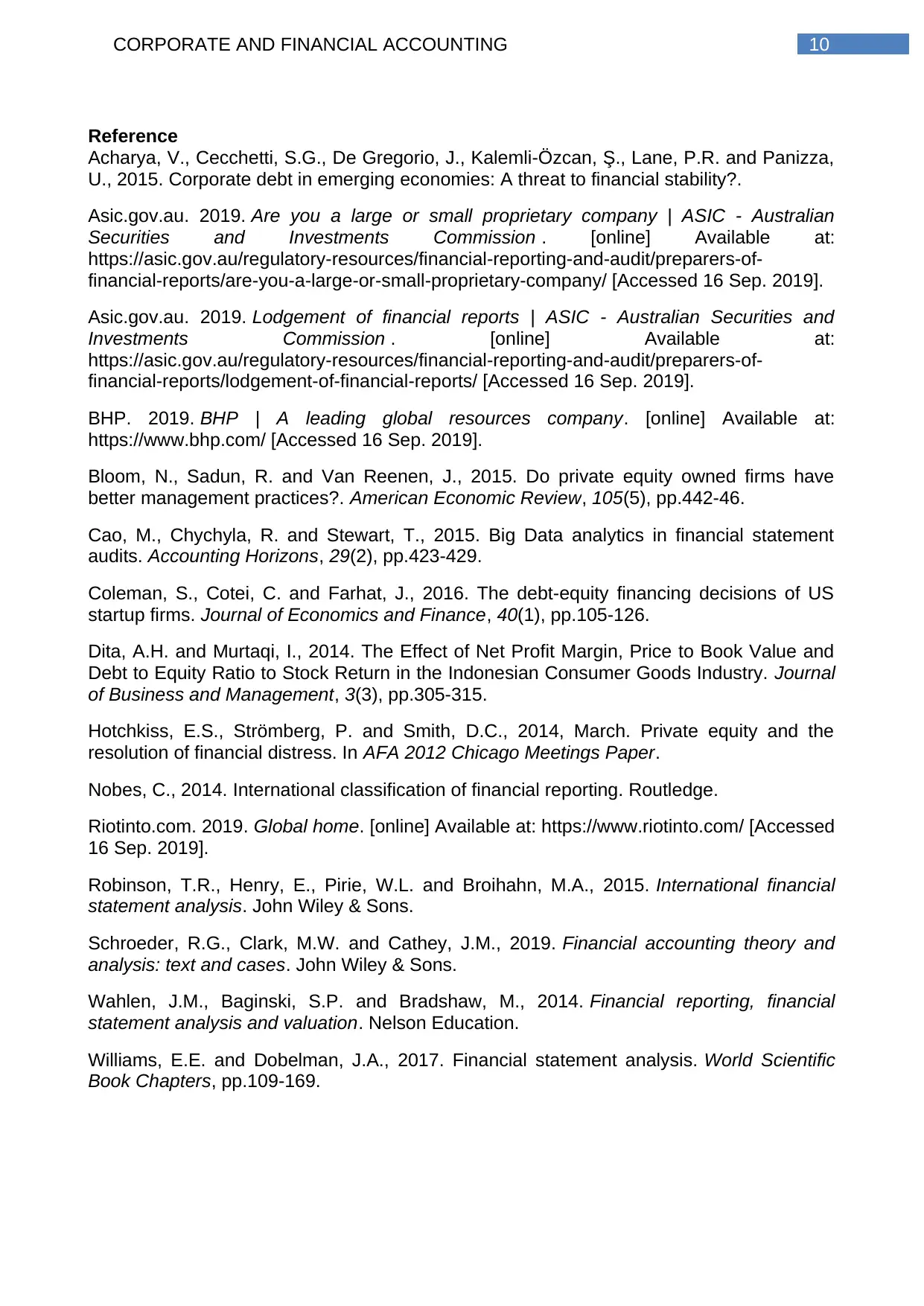
10CORPORATE AND FINANCIAL ACCOUNTING
Reference
Acharya, V., Cecchetti, S.G., De Gregorio, J., Kalemli-Özcan, Ş., Lane, P.R. and Panizza,
U., 2015. Corporate debt in emerging economies: A threat to financial stability?.
Asic.gov.au. 2019. Are you a large or small proprietary company | ASIC - Australian
Securities and Investments Commission . [online] Available at:
https://asic.gov.au/regulatory-resources/financial-reporting-and-audit/preparers-of-
financial-reports/are-you-a-large-or-small-proprietary-company/ [Accessed 16 Sep. 2019].
Asic.gov.au. 2019. Lodgement of financial reports | ASIC - Australian Securities and
Investments Commission . [online] Available at:
https://asic.gov.au/regulatory-resources/financial-reporting-and-audit/preparers-of-
financial-reports/lodgement-of-financial-reports/ [Accessed 16 Sep. 2019].
BHP. 2019. BHP | A leading global resources company. [online] Available at:
https://www.bhp.com/ [Accessed 16 Sep. 2019].
Bloom, N., Sadun, R. and Van Reenen, J., 2015. Do private equity owned firms have
better management practices?. American Economic Review, 105(5), pp.442-46.
Cao, M., Chychyla, R. and Stewart, T., 2015. Big Data analytics in financial statement
audits. Accounting Horizons, 29(2), pp.423-429.
Coleman, S., Cotei, C. and Farhat, J., 2016. The debt-equity financing decisions of US
startup firms. Journal of Economics and Finance, 40(1), pp.105-126.
Dita, A.H. and Murtaqi, I., 2014. The Effect of Net Profit Margin, Price to Book Value and
Debt to Equity Ratio to Stock Return in the Indonesian Consumer Goods Industry. Journal
of Business and Management, 3(3), pp.305-315.
Hotchkiss, E.S., Strömberg, P. and Smith, D.C., 2014, March. Private equity and the
resolution of financial distress. In AFA 2012 Chicago Meetings Paper.
Nobes, C., 2014. International classification of financial reporting. Routledge.
Riotinto.com. 2019. Global home. [online] Available at: https://www.riotinto.com/ [Accessed
16 Sep. 2019].
Robinson, T.R., Henry, E., Pirie, W.L. and Broihahn, M.A., 2015. International financial
statement analysis. John Wiley & Sons.
Schroeder, R.G., Clark, M.W. and Cathey, J.M., 2019. Financial accounting theory and
analysis: text and cases. John Wiley & Sons.
Wahlen, J.M., Baginski, S.P. and Bradshaw, M., 2014. Financial reporting, financial
statement analysis and valuation. Nelson Education.
Williams, E.E. and Dobelman, J.A., 2017. Financial statement analysis. World Scientific
Book Chapters, pp.109-169.
Reference
Acharya, V., Cecchetti, S.G., De Gregorio, J., Kalemli-Özcan, Ş., Lane, P.R. and Panizza,
U., 2015. Corporate debt in emerging economies: A threat to financial stability?.
Asic.gov.au. 2019. Are you a large or small proprietary company | ASIC - Australian
Securities and Investments Commission . [online] Available at:
https://asic.gov.au/regulatory-resources/financial-reporting-and-audit/preparers-of-
financial-reports/are-you-a-large-or-small-proprietary-company/ [Accessed 16 Sep. 2019].
Asic.gov.au. 2019. Lodgement of financial reports | ASIC - Australian Securities and
Investments Commission . [online] Available at:
https://asic.gov.au/regulatory-resources/financial-reporting-and-audit/preparers-of-
financial-reports/lodgement-of-financial-reports/ [Accessed 16 Sep. 2019].
BHP. 2019. BHP | A leading global resources company. [online] Available at:
https://www.bhp.com/ [Accessed 16 Sep. 2019].
Bloom, N., Sadun, R. and Van Reenen, J., 2015. Do private equity owned firms have
better management practices?. American Economic Review, 105(5), pp.442-46.
Cao, M., Chychyla, R. and Stewart, T., 2015. Big Data analytics in financial statement
audits. Accounting Horizons, 29(2), pp.423-429.
Coleman, S., Cotei, C. and Farhat, J., 2016. The debt-equity financing decisions of US
startup firms. Journal of Economics and Finance, 40(1), pp.105-126.
Dita, A.H. and Murtaqi, I., 2014. The Effect of Net Profit Margin, Price to Book Value and
Debt to Equity Ratio to Stock Return in the Indonesian Consumer Goods Industry. Journal
of Business and Management, 3(3), pp.305-315.
Hotchkiss, E.S., Strömberg, P. and Smith, D.C., 2014, March. Private equity and the
resolution of financial distress. In AFA 2012 Chicago Meetings Paper.
Nobes, C., 2014. International classification of financial reporting. Routledge.
Riotinto.com. 2019. Global home. [online] Available at: https://www.riotinto.com/ [Accessed
16 Sep. 2019].
Robinson, T.R., Henry, E., Pirie, W.L. and Broihahn, M.A., 2015. International financial
statement analysis. John Wiley & Sons.
Schroeder, R.G., Clark, M.W. and Cathey, J.M., 2019. Financial accounting theory and
analysis: text and cases. John Wiley & Sons.
Wahlen, J.M., Baginski, S.P. and Bradshaw, M., 2014. Financial reporting, financial
statement analysis and valuation. Nelson Education.
Williams, E.E. and Dobelman, J.A., 2017. Financial statement analysis. World Scientific
Book Chapters, pp.109-169.
1 out of 11
Your All-in-One AI-Powered Toolkit for Academic Success.
+13062052269
info@desklib.com
Available 24*7 on WhatsApp / Email
![[object Object]](/_next/static/media/star-bottom.7253800d.svg)
Unlock your academic potential
© 2024 | Zucol Services PVT LTD | All rights reserved.





